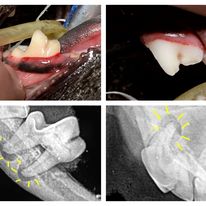Say Cheese!
- Dr. Andrew Hodges
- Sep 22, 2022
- 3 min read
Did you know that the number one disease affecting
dogs and cats is dental disease?

Maintaining good oral health is as important for your pet as it is for us. If you brush your dogs or cats teeth once a day with a pet tooth paste and brush or dental wipe the chance of those pets requiring tooth extractions as they age will decrease by 90%. Can you imagine if you never brushed your teeth?
Within hours of eating plaque begins to form on teeth that can eventually mineralize into calculus or tartar. This tartar is the start of dental disease. It provides a good hiding place for bacteria and can irritate the gums leading to periodontal disease. Periodontal disease is when bacteria attack the tissues that hold teeth in place. They can even destroy the bone around the teeth creating pockets that become filled with pus. 85% of cats and dogs over 3 years of age have periodontal disease somewhere in their mouth. When the periodontal disease becomes severe owners will often report that their pets breath has become horribly smelly. Without treatment the animal will suffer with chronic pain, possibly get heart liver or kidney disease due to bacteria in the blood stream, and eventually lose teeth.
Signs of dental disease include bad breath, loose teeth or teeth that are discolored or covered in tartar, your pet shies away from you when you touch the mouth area, drooling or dropping food from the mouth, bleeding from the mouth, loss of appetite or loss of weight (this combination can result from diseases of many organs, and early veterinary intervention is important).
Once periodontal disease has started the only treatment to stop the disease process is a professional dental cleaning. This treatment can only be done under general anesthesia. A complete oral examination, which is an important part of a professional dental cleaning procedure, is not possible in an awake patient. The surfaces of the teeth facing the tongue cannot be examined, dental x-rays cannot be taken, and areas of disease and discomfort are likely to be missed. The most important part of the cleaning/scaling is the removal of bacteria and tartar underneath the gum line where the active disease process is going on. This can be painful and cannot be performed in an awake patient. A dental cleaning in an animal with periodontal disease without scaling under the gums does not improve oral health it just makes the teeth look cleaner in the short term and gives the owner a false sense of security.
As most pets that we perform dental cleanings on are older and have never had their teeth brushed they often require preanesthetic blood work, IV fluids, dental x-rays, and sadly extractions. Depending on the severity of the disease present the procedure can become quite costly. This is unfortunate when simply brushing once a day makes such a huge difference. It is important to start brushing at an early age and make it a fun and exciting event for your pet. Not all older pets will tolerate teeth brushing, some already have painful disease in their mouth and others won’t understand the fun and excitement no matter how much you try and convince them. For these pets there are special diets designed to brush their teeth while they eat.
A few years ago, I began taking advanced dentistry courses and joined the American Veterinary Dental Society. I was absolutely amazed at the procedures available; braces, root canals, bridges, crowns, implants… Not all vet clinics will offer these procedures, but these options are available. As pet owners we should strive to provide our pets with a disease-free pain free mouth. The easiest and least expensive way to achieve this is by brushing those teeth. If I never had to extract another tooth, I would be a happy veterinarian.
If you haven’t looked at your pets teeth in a while do it now. Feel free to call or drop by and book an appointment for a complimentary dental exam for your pet or discuss your pets dental health and our dental health promotions with one of our professional staff. Keep on smiling.










Comments